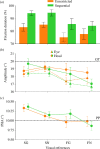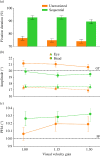Active head movements contribute to spatial updating across gaze shifts
- PMID: 39113764
- PMCID: PMC11305413
- DOI: 10.1098/rsos.231545
Active head movements contribute to spatial updating across gaze shifts
Abstract
Keeping visual space constant across movements of the eye and head is a not yet fully understood feature of perception. To understand the mechanisms that update the internal coordinates of space, research has mostly focused on eye movements. However, in natural vision, head movements are an integral part of gaze shifts that enlarge the field of vision. Here, we directly compared spatial updating for eye and head movements. In a virtual reality environment, participants had to localize the position of a stimulus across the execution of a gaze shift. We found that performing head movements increased the accuracy of spatial localization. By manipulating the speed of the visual scene displacement that a head movement produced, we found that spatial updating takes into account the sensorimotor contingencies of vision. When we presented gaze-contingent visual motion, subjects overestimated the position of stimuli presented across gaze shifts. The overestimation decreased if subjects were allowed to perform eye movements during the head movement. We conclude that head movements contribute to stabilizing visual space across gaze shifts and that contingencies of head movements, rather than being cancelled, facilitate the updating.
Keywords: eye movement; head movement; self-motion; space constancy.
© 2024 The Authors.
Conflict of interest statement
We declare we have no competing interests.
Figures





Similar articles
-
Serial dependencies in visual stability during self-motion.J Neurophysiol. 2023 Aug 1;130(2):447-457. doi: 10.1152/jn.00157.2023. Epub 2023 Jul 19. J Neurophysiol. 2023. PMID: 37465870
-
Experimental test of spatial updating models for monkey eye-head gaze shifts.PLoS One. 2012;7(10):e47606. doi: 10.1371/journal.pone.0047606. Epub 2012 Oct 31. PLoS One. 2012. PMID: 23118883 Free PMC article.
-
Gaze-contingent processing improves mobility, scene recognition and visual search in simulated head-steered prosthetic vision.J Neural Eng. 2024 Apr 10;21(2). doi: 10.1088/1741-2552/ad357d. J Neural Eng. 2024. PMID: 38502957
-
Spatial updating and the maintenance of visual constancy.Neuroscience. 2008 Oct 28;156(4):801-18. doi: 10.1016/j.neuroscience.2008.07.079. Epub 2008 Aug 22. Neuroscience. 2008. PMID: 18786618 Free PMC article. Review.
-
Eye Movement Compensation and Spatial Updating in Visual Prosthetics: Mechanisms, Limitations and Future Directions.Front Syst Neurosci. 2019 Feb 1;12:73. doi: 10.3389/fnsys.2018.00073. eCollection 2018. Front Syst Neurosci. 2019. PMID: 30774585 Free PMC article. Review.
References
LinkOut - more resources
Full Text Sources

